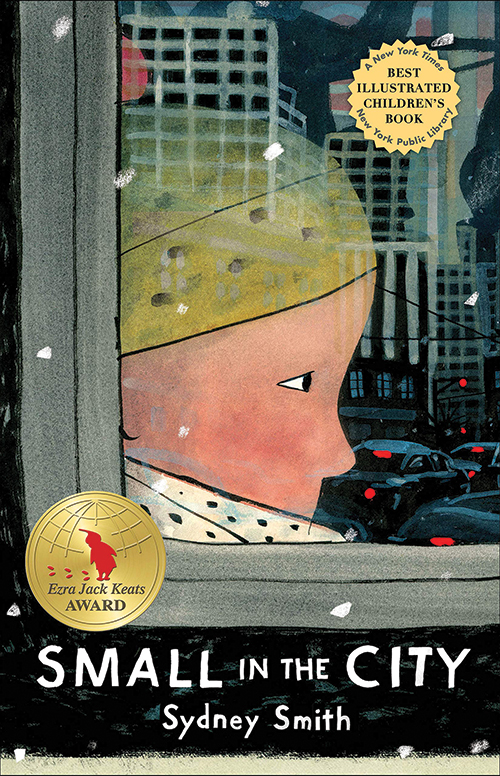
Small in the City
Reviewed by Alison James
December 1, 2020
By Sydney Smith. Neal Porter Books, 2019. 40 pages. $18.99/hardcover; $11.99/eBook. Recommended for ages 4–8.
This book opens in silence with two pages of illustrations, showing the point of view of a child traveling alone through a snowy city. Smith uses limited color to show dynamic change, such as eye-catching dabs of red in a blurry, wet cityscape, seen from the window of the bus. Off the bus and on the sidewalk, the child is dwarfed by buildings and wires and traffic lights and people. The text reads: “I know what it’s like to be small in the city.” Instantly, the words deepen the image, and we, too, feel small and insignificant. The illustrations range from spreads across double pages to graphic novel style with mini-squares, showing detail after detail, as this child searches the city and narrates encouragement and support to someone unseen. “There are lots of good places to hide, like under this mulberry bush” or “There is a dryer vent that breathes out hot steam that smells like summer.” But it isn’t until we see the fishmonger that we begin to get a glimmer of the situation: “They would probably give you a fish if you asked.” Their cat has gone missing, and the child is trying to find it by putting up posters and giving survival advice: “I know you like to listen to music. . . . You could perch on the window ledge.”
The snow gets heavier, the illustrations darker, and the narration becomes a little desperate: “If you want, you could just come back.” Then we are left in silence as the child trudges home, and finds comfort in a mother’s hug. On the final page—to shuddering relief—we see footprints leading to their door. This is such a deep story about loss, about searching, about giving permission to someone to live the life they choose, even if it isn’t the life you would want. It has gripping emotions, with enough room in the illustrations and the graceful pacing to allow the reader to feel the loss deeply. Small in the City can help us grapple with this kind of nuanced, complex situation, and come to a sense of peace. And then, only then, the cat comes back.
Alison James is a member of South Starksboro (Vt.) Meeting.


